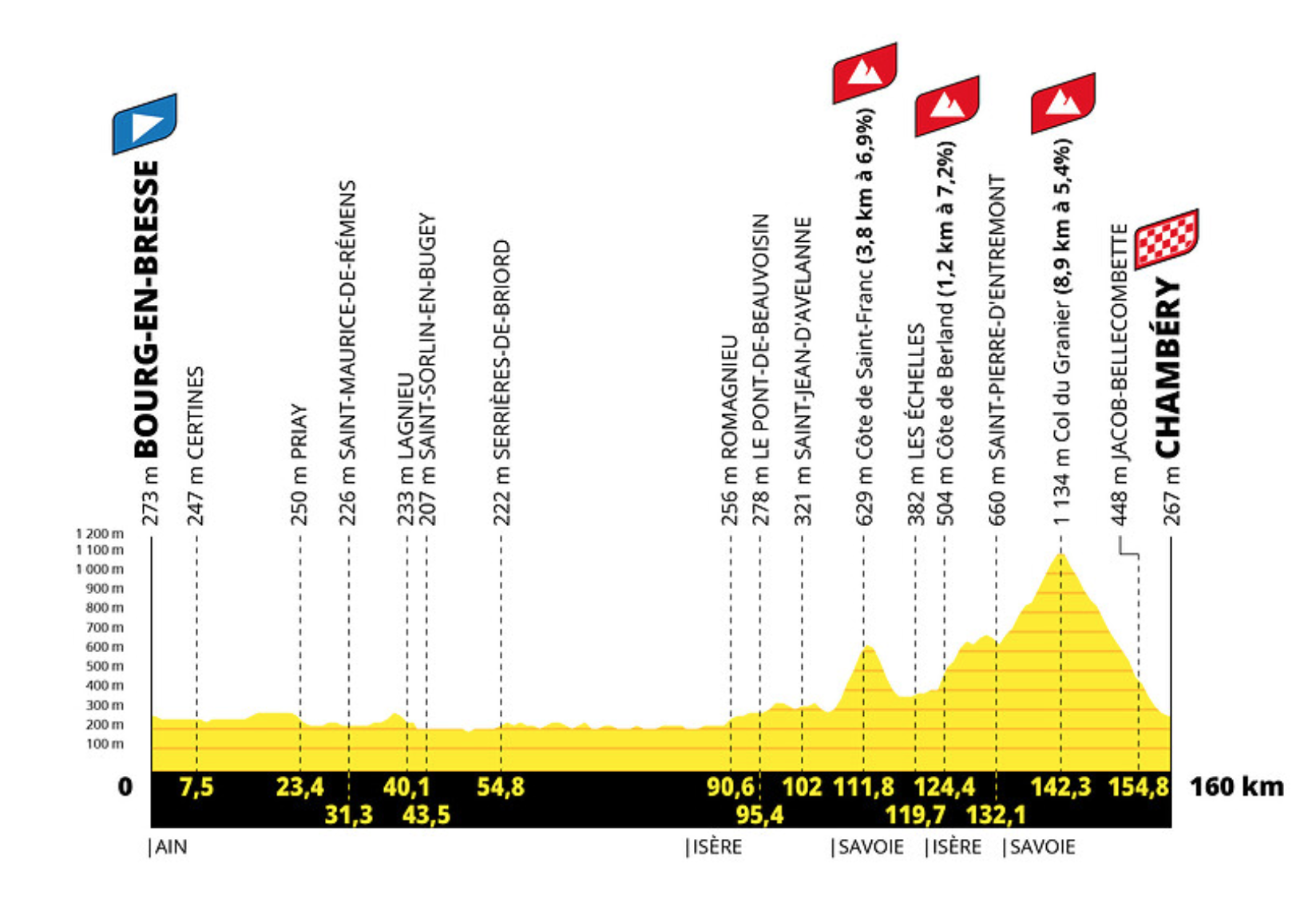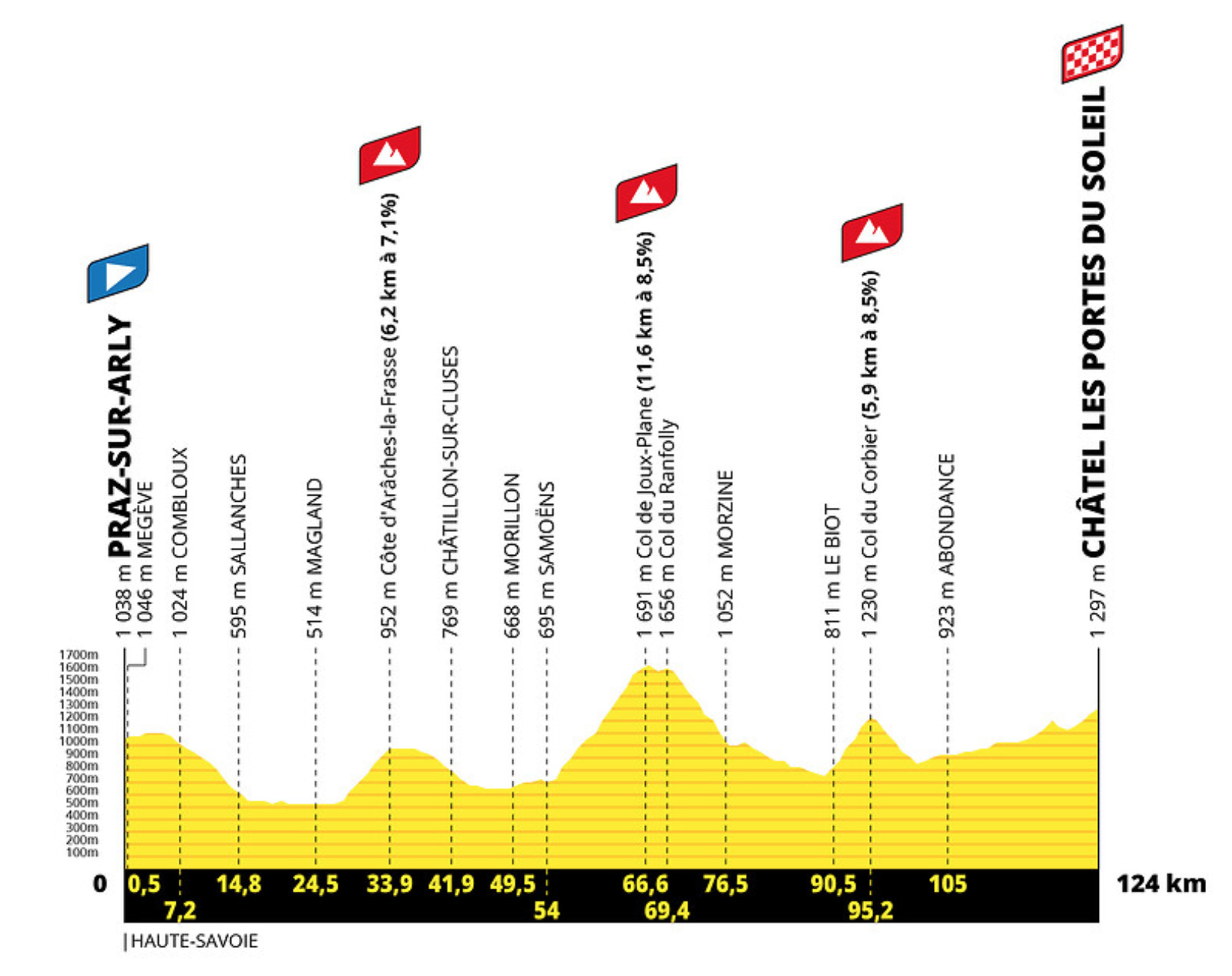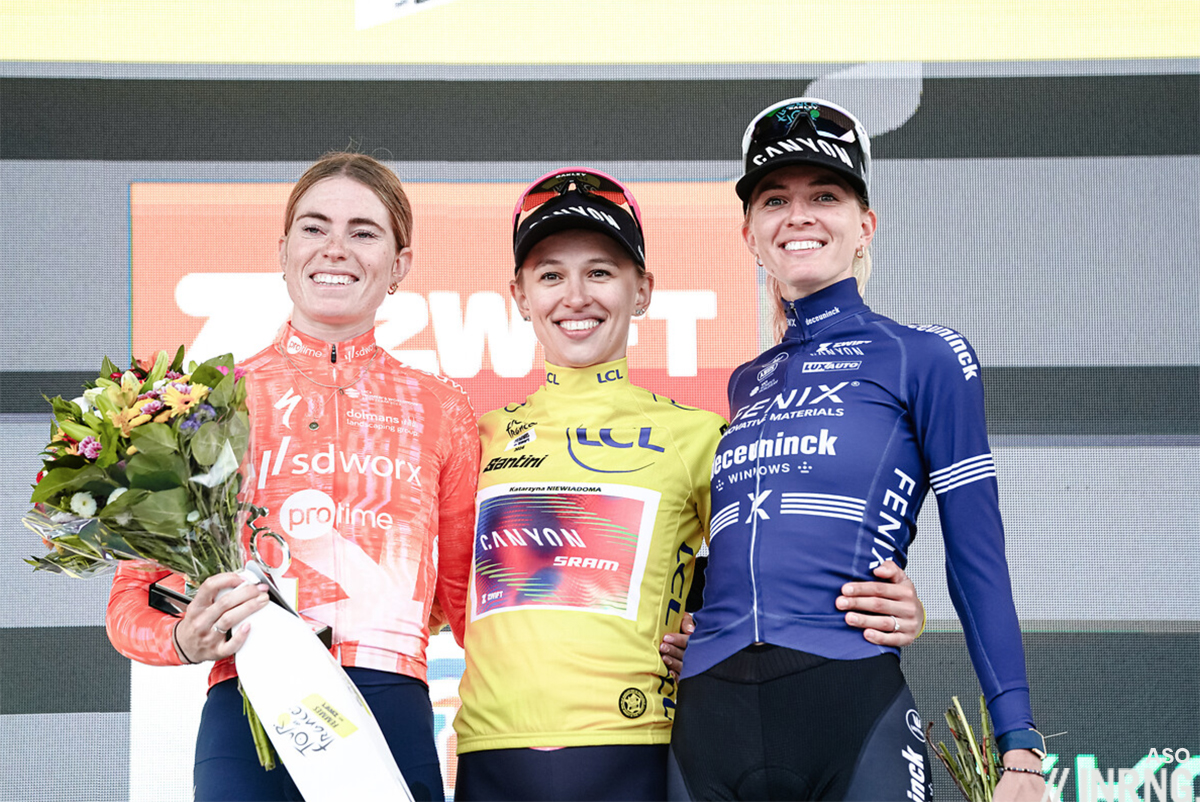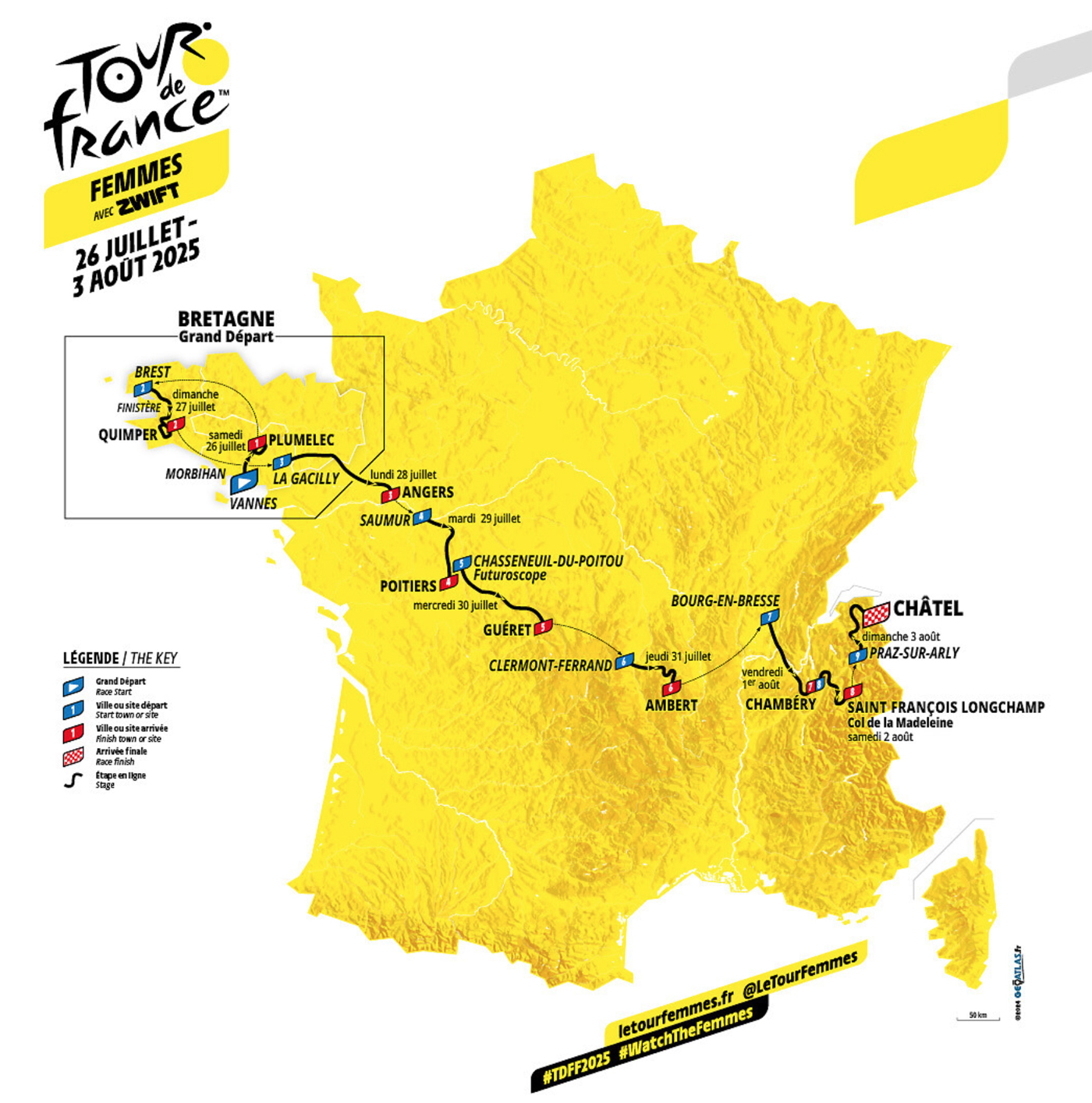A closer look at the 2025 Tour de France Femmes by Zwift route. There’s a full traverse of France, an extra day of racing and some famous climbs

The first thing to note about Stage 1, is an extra day added. It now spans two full weekends now. The start on Saturday 26 July overlaps with the men’s Tour which is onto Stage 20 by now. This might explain the short distance at 79km so that both races can be broadcast, we’ll see the timing and TV schedules later. This features the Côte de Cadoudal three times, the climb is a staple of the GP du Morbihan race for men and women. Expect big crowds as it’s Brittany in summer, a region where many describe themselves as Breton first, French second and where cycling is surely most popular, it is more racing licences by far than other regions and the local newspapers are full of reports from World Tour transfer gossip to village cyclo-cross.

Stage 2 (110km) and if you’re feeling déjà vu it might be from the opening stages of the 2018 men’s Tour like Stage 5 which featured the cobbled climb to Locronan en route to Quimper. Back then it was sold as a day where the jagged hills of Brittany could blow the peloton to smithereens… only it finished in a sizeable sprint. This time Locronan is cited as “severe” but it’s not really. The finishing loop has some more climbing but the Chemin du Troheir is just a regular country road, enough to test some sprinters but no more.

Stage 3 (162km) and the first day reserved for les sprinteuses. The start is in the small town of La Gacilly which is dominated by Yves Rocher, the beauty products company that controversially initiated the late Russian opposition leader Alexei Navalny’s one way slide down the Russian judicial system. Bet you didn’t expect to read that in a route preview. It’ll be interesting to see if the company is airbrushed out despite having hotels, restaurants, gardens and factories all around; or if it’s unveiled as a new sponsor? It’s a route that heads to the Loire valley and some of its best wines so look for the peloton passing vineyards of ripening Cabernet franc before finishing close to the banks of the Maine in city of Angers.

Stage 4 (128km) and another day with a likely sprint finish. More Loire valley vineyards at the time and then its south towards Poitiers across land without much to write about although the route passes the Futuroscope theme park which has a long connection to cycling having hosted the men’s Tour start before and also been a sponsor of what is the FDJ-Suez team today, the team’s HQ is just up the road. There’s no full map yet but Poitiers is hillier than you’d imagine and the men have had uphill finishes here, or at least a ramp to derail sprint trains in the finish.

Stage 5 (166km) and Futuroscope features properly at the start and then the hills arrive. There’s more déjà vu as the race goes to Dun-le-Palestel which featured in Paris-Nice in 2022. Just like then, the climb of the “Côte de Peyroux” was downplayed: 2.8km at 5.2% for 2021, here it’s 3.3km at 4.3%. It’s actually the Col de Peyroux as in a mountain pass. More importantly it’s 10km long and has plenty of 6%. Alpine it isn’t though, but it 2021 it asphyxiated many of the pure sprinters. Rather than ride into the small city of Guéret there’s a loop out to tackle the Le Maupuy to add more climbing. The rasping tarmac here has featured in the Tour du Limousin before a surprisingly fast descent to the finish.

Stage 6 (124km, 2,350mV) and the mountains arrive. It’s flat for a short moment after Clermont then it’s across lumpy roads to the Dore valley and Olliergues where soon after the Col du Béal starts. Scene of a ding-dong battle between Chris Froome and Alberto Contador a decade ago, this time it’s a different route up via the Pas de la Croix pass to the Béal but similar in feel as it tracks up through the chestnut woodland on a road that never gets too steep. The race stays amid the forested flanks of the Massif central for two more climbs on narrow roads before dropping into Ambert for the finish.

If the weather’s good then the Alps will be visible soon after the start of Stage 7 (km, 1,880mV+) even if there’s 100km across the plains of the Ain, Rhone and Isère first. The first climb near Saint Franc features as a detour on the way to the Gorges du Guiers vif and adds more climbing. Then it’s the long Col du Granier, 20km in total even if the profile above tries to break it up into more climbs and why not as it’s taken via the gentle western side. Finaly a fast but not wild descent that leads into Chambéry for the finish.

Stage 8 (112km, 3,490mV+) starts straight up Mont Revard to tackle the Col de Plainpalais and then tour the Plateau des Bauges, a land of lush pastures and clanging cowbells before leaving via the Col du Frêne, one of those asymmetric passes which is climbed via the easy side before a descent that’s frêne for frenetic. There are short cuts over the Maurienne valley but race stays on the valley floor before the scenic balcony road to Saint-Georges. The Col Madeleine is a giant, 18.6km at a steep 8.1% making this the decisive summit finish. As ever whisper it but the real height is 1,993m but the label of 2,000m just looks better.

Stage 9 (124km, 2880mV+)and a chance for revenge if someone got the previous day all wrong. It’s downhill out of Megève to the valley floor. The “Côte d’Arâches” is a scenic cliff road on the way to the Flaine ski resort before turning to take a balcony road across. Then comes the fearsome Joux-Plane, where 11.5km at 8.5% is hard enough but the climb somehow conspires to feel harder, probably because the early slopes are steep and irregular. Then comes the toboggan-run descent to Morzine before the main valley road and the hard Col du Corbier which lifts the race over the Abondance valley. From here it’s the main road and so a repeat of last summer’s stopwatch suspense at the last minute seems unlikely but the Joux-Plane is so tough up and down that it could open the stage wide up early on. The finish is Châtel but the route goes through the ski resort and then up and out the other side for a finish in Pré La Joux, the same used for the men in 2022.

The Verdict
A pleasing diagonal shape, from the western most point of Finistère to the Swiss border to tour plenty of France. As a week-long stage race does the women’s race have to mimic the men’s race with flat stages building to result-shaping mountain stages in the Alps and Pyrenees? Arguably not but it is and with this establishing itself as the prime stage race. Using famous climbs bolsters this, importing “brands” like the Col du Tourmalet and Alpe d’Huez before, now the Madeleine and Joux-Plane. Next year the Galiber or Mont Ventoux?
Sports-wise the Tourmalet in 2023 was seen by some as bold because it could be almost too selective but it worked out well. Come 2024 and Alpe d’Huez was even better with a finale the organisers didn’t dare to script. So hopefully the Madeleine and Joux-Plane deliver too.

Like the men’s route it’s also worth pondering what is not there and the obvious omission is a time trial. Given Demi Vollering won the Rotterdam stage this year, perhaps the absence of the TT is no bad thing, more climbers can be in contention going into the final weekend after which there should be no doubting the winner and the podium order. Vollering ought to be the central pick but her move is one of several changes across the top teams this winter and the reallocation of talent and resources should be interesting to see next season, including at the Tour.


It’s really nice to see an additional day added on, but I’d like to see it extended to a full two weeks in the future. Apart from the lack of a TT, it’s also hard to see an obvious breakaway stage (although women’s races tend to have way more surprises, so we’ll see). Given the profiles, I won’t be shocked at all if Kopecky is in yellow for at least the first four stages, maybe longer depending how things go. I have to say, though, that I really want to see Vollering put her to the sword to pay her back for everything that happened throughout all of this last season (not just the TDF). I can’t recall a team so thoroughly selling their own leader down the river the way SD-Worx did to Vollering. Hopefully FDJ-Suez can function as a team, not just a disjointed collection of egos that SD-Worx has been for at least two years now.
It does look suitable for Kopecky at the start. Having had my Eurosport subscription binned like everyone else, I stuck to local broadcasters for the races since August so don’t know if it was on Eurosport or just with the host Swiss TV but there were “backstage” footage of the Tour de Romandie where Kopecky and Vollering had just contested the summit finish stage win and Vollering had to warm-down away from her team mate, as if it was too much to have their bikes on rollers next to each other. In short you could see the tension in this more than any polite interview before or since.
I know we can’t have a thriller like 2024 in every year, the final stage looks a bit underwhelming compared to the last editions. But the way the women ride their races, I wouldn’t be surprised if we still get some suspense on the last day.
For sure better than any festive procession into Paris.
The negative impact on the Giro Donne, sorry Giro d’Italia Women, still the best stage races for women under a purely cycling perspective IMHO (not by much if at all and anyway surely not for long), is something which I believe the UCI should have taken better care of, trying some mediation or negotiation between the interested parties, or simply looking for a way to grant some transition support to the Italian race. Yeah, not the sort of things which happen much in cycling, I know (even if they sometimes do happen, actually, as with the men’s Itzulia).
Or maybe they did, and hence got RCS involved, for good or ill.
Now, after keeping for three decades the standard of 10 days of racing, with very few negative exceptions and some positive ones in 12-14 days of racing (at the end of the 90s and beginning of the 2000s), we’re apparently going to be definitely down to 8. I hope the ruote isn’t getting any tuning down, as in the past we often got – again, with notable exceptions – a good deal of great courses. Serious material.
Of course, no hope you can “compete” with ASO, and two fine races are still better than a great one, even more so as the latter suffered sometimes from a serious lack of professionalism on the organisers’ side (depending on financial context and the specific organisation in charge). However what many people achieved for women cycling keeping the Giro alive across very dire times, even when the subculture dominating international institutions was one of the most sexist ever, well, it is worth to be remembered and respected.
Let me add, to be clear, the the TDF Femmes has been having an excellent course design, plus step by step growth also looks a good idea – and I have actually enjoyed much following it, unlike La Course which also had a couple of memorable editions, of course, but which I generally found too much of an exercise of hypocrisy, generating troubles to other races but without contributing enough to the whole movement, plus too often more prone to step back rather than further on.
I think one of the positive developments in men’s cycling has been the consolidation of the places the grand tours occupy on the calendar. The women’s calendar, in many ways, is still in a state of flux, with races disappearing then returning, changing dates, and new races being created. As things stand now, the women’s Giro and the TDFF are stepping on each other’s toes, and it’s not really in the interest of either race (or the riders themselves) to have things this way. A clearer sequencing of the women’s calendar would allow riders to target races in a more logical way, and give organizers a better opportunity to grow their races organically. As it stands, it certainly looks like ASO is really only interested in staking out their territory without a lot of consideration for how that affects other races. I don’t know if the various stakeholders involved in planning the calendar ever sit down in the same room and talk these things through. If not, they need to.
I think the UCI gets a lot of criticism for things really outside of their control, but it seems like a good race calendar should be one of their main duties.
The amateur organising committee which ran the Giro Donne has had their licence revoked by the Italian federation and RCS Sport awarded the rights to organise a women’s Giro d’Italia.
I’m not sure the former organisers really deserve much praise, given they usually spent more time focusing on staying one step ahead of their creditors than with putting on a great cycling event.
This carries with it a resolution of the trademark issues, and therefore a chance that the women’s Giro can shift to a spot in the calendar more aligned with the Giro d’Italia itself like the Tour Femmes is with the Tour de France.
Besides the fact you’re speaking of one organiser in literally decades of different ones (do you refer to the last one or which?) I’d love to read your sources because local ones tell a very different story…
https://www.tuttobiciweb.it/article/2022/07/10/1657444258/stagi-annemiek-van-vleuten-marta-cavalli-elisa-longo-borghini-elisa-balsamo
https://www.cicloweb.it/news/206182977030/rcs-sport-organizzera-giro-femminile-e-giro-u23
https://www.inbici.net/tutti-gli-articoli/giro-donne-2023-laccordo-tra-federciclismo-e-rai-salva-la-corsa-a-sette-giorni-dalla-partenza/
You apparently pretend to be well informed but it looks more like you have little idea.
I’d love to add that ol’ story about TV broadcasting but let’s go step by step, to start with.
Hi Dave, could you please post your sources? And specify what organisers you’re referring to, just in case they want to sue you or inrng 😛
From my local POV you look poorly informed, to say the least.
I linked some coverage of the story but as they were three links (from three different specialist local media), my comment needs moderation.
I like the course. The ASO did well not to give in to the temptation to try to repeat the incredibly exciting finale of this year’s TdFF. But it’s somewhat strange to have a Grand Tour without a TT. It didn’t have to be long, but somehow something is missing for me.
On a sidenote: The ASO will be holding a cyclosportive “L’Etape du Tour de France Femmes” on the route of the stage to Madeleine. Looks like it will be in the morning before the women’s race. I hope that many participants will stay up at the Madeleine and bring more spectators to the women’s race.
Agree about the TT. Wouldn’t want it to be too decisive, but it should be there.
There’s no GC rider in the women’s peloton who would be a huge favorite in a TT the way Remco is in the men’s. Vollering is probably a step above, but can definitely be beaten if she’s not on a perfect day. There are, however, a large number of GC hopefuls who would lose a significant amount of time in a TT, though, so maybe the omission of the TT is a way of keeping things closer in GC. Also, team budgets for women’s teams are a lot more unequal, and not every team can really afford proper wind tunnel fine tuning of rider position etc. Still, if more stages are added in the future, a TT definitely needs to be included.
I think the organizers were wise to backload the climbs in this race, because it sure looks like Vollering will be well ahead after Stage 8. It should be a good test case of the difference between a team coalescing around one rider and a bunch of individuals riding their own races. I would love to see the drama last until the final stage, but it seems like a lot to ask, especially since Demi will have revenge on her mind. Like the men’s version, the first half of the race should have some good storylines that may not have much of an impact on the GC, and there are almost always surprises that throw a little extra uncertainty in the mix. But after the insanity of last year’s TDFF (avec Zwift), it’s hard to imagine anything quite like that.
*Not last year’s, this year’s.